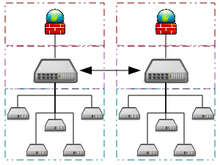User:Spirited91/sandbox
In Computer science, inter-process communication (IPC) is the activity of sharing data across multiple and commonly specialized processes using communication protocols. Typically, applications using IPC are categorized as clients and servers, where the client requests data and the server responds to client requests.[1] Many applications are both clients and servers, as commonly seen in distributed computing. Methods for achieving IPC are divided into categories which vary based on software requirements, such as performance and modularity requirements, and system circumstances, such as network bandwidth and latency.[2]

There are several reasons for implementing inter-process communication systems:
- Sharing information. For example, web servers use IPC to share web documents and media with users through a web browser.
- Distributing labor across systems. For example, Wikipedia uses multiple servers that communicate with one another using IPC to process user requests.[3]
- Privilege separation. For example, HMI software systems are separated into layers based on privileges to minimize the risk of attacks. These layers communicate with one another using encrypted IPC.
Approaches
[edit]| Method | Short Description | Provided by (operating systems or other environments) |
|---|---|---|
| File | A record stored on disk, or a record synthesized on demand by a file server, which can be accessed by multiple processes. | Most operating systems |
| Signal | A system message sent from one process to another, not usually used to transfer data but instead remotely command the partnered process. | Most operating systems |
| Socket | A data stream sent over a network interface, either to a different process on the same computer or to another computer on the network. | Most operating systems |
| Message queue | An anonymous data stream similar to a socket, usually implemented by the operating system, that allows multiple processes to read and write to the message queue without being directly connected to each other. | Most operating systems |
| Pipe | A two-way data stream between two processes interfaced through standard input and output and read in one character at a time. | All POSIX systems, Windows |
| Named pipe | A pipe implemented through a file on the file system instead of standard input and output. Multiple processes can read and write to the file as a buffer for IPC data. | All POSIX systems, Windows |
| Semaphore | A simple structure that synchronizes multiple processes acting on shared resources. | All POSIX systems, Windows |
| Shared memory | Multiple processes are given access to the same block of memory which creates a shared buffer for the processes to communicate with each other. | All POSIX systems, Windows |
| Message passing | Allows multiple programs to communicate using channels, commonly used in concurrency models. | Used in MPI paradigm, Java RMI, CORBA, DDS, MSMQ, MailSlots, QNX, others |
| Memory-mapped file | A file mapped to RAM and can be modified by changing memory addresses directly instead of outputting to a stream. This shares the same benefits as a standard file. | All POSIX systems, Windows |
Implementations
[edit]There are several mechanisms which may be used for IPC, including the following:
- Anonymous pipes and named pipes
- Unix domain sockets
- 9P
- Common Object Request Broker Architecture (CORBA)
- D-Bus
- Distributed Computing Environment (DCE)
- Message Bus (Mbus) (specified in RFC 3259)
- MCAPI Multicore Communications API
- Lightweight Communications and Marshalling (LCM)
- ONC RPC
- XML XML-RPC or SOAP
- JSON JSON-RPC
- Thrift
- TIPC
- ZeroC's Internet Communications Engine (ICE)
- ØMQ
The following are platform or programming language specific APIs:
- Apple Computer's Apple events (previously known as Interapplication Communications (IAC)).
- Enea's LINX for Linux (open source) and various DSP and general purpose processors under OSE
- IPC implementation from CMU.
- Java's Remote Method Invocation (RMI)
- KDE's Desktop Communications Protocol (DCOP) - Now deprecated. D-Bus is used instead.
- Libt2n for C++ under Linux only, handles complex objects and exceptions
- The Mach kernel's Mach Ports
- Microsoft's ActiveX, Component Object Model (COM), Microsoft Transaction Server (COM+), Distributed Component Object Model (DCOM), Dynamic Data Exchange (DDE), Object Linking and Embedding (OLE), anonymous pipes, named pipes, Local Procedure Call, MailSlots, Message loop, MSRPC, .NET Remoting, and Windows Communication Foundation (WCF)
- Novell's SPX
- PHP's sessions
- POSIX mmap, message queues, semaphores, and shared memory
- RISC OS's messages
- Solaris Doors
- System V's message queues, semaphores, and shared memory
- Distributed Ruby
- OpenBinder Open binder
- IPC Shared Memory Messaging from Solace Systems
- QNX's PPS (Persistant Publish/Subscribe) service
- SIMPL The Synchronous Interprocess Messaging Project for Linux (SIMPL)
See also
[edit]- Computer network programming
- Communicating Sequential Processes (CSP paradigm)
- Data Distribution Service
- .NET Remoting
- Microkernel
- Nanokernel
- Protected procedure call
References
[edit]- Stevens, Richard. UNIX Network Programming, Volume 2, Second Edition: Interprocess Communications. Prentice Hall, 1999. ISBN 0-13-081081-9
- U. Ramachandran, M. Solomon, M. Vernon Hardware support for interprocess communication Proceedings of the 14th annual international symposium on Computer architecture. Pittsburgh, Pennsylvania, United States. Pages: 178 - 188. Year of Publication: 1987 ISBN 0-8186-0776-9
- Crovella, M. Bianchini, R. LeBlanc, T. Markatos, E. Wisniewski, R. Using communication-to-computation ratio in parallel program designand performance prediction 1–4 December 1992. pp. 238–245 ISBN 0-8186-3200-3
External links
[edit]- Linux ipc(5) man page describing System V IPC
- Windows IPC
- Beej's Guide to Unix IPC
- Unix Network Programming (Vol 2: Interprocess Communications) by W. Richard Stevens
- Interprocess Communication and Pipes in C
